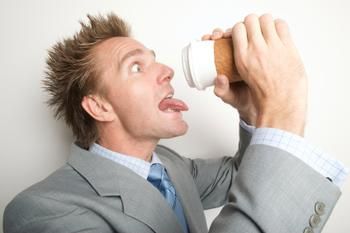
© sodahead.com
Caffeine is part of many people's daily lives - mainly in the coffee we drink, but also in the tea, soda and energy drinks we consume, the candy and cereal we eat, the pain relievers and weight-loss pills we take. It's found so often in common products that people may not realize caffeine is indeed a drug - the world's most widely used one. We love it because it is a
stimulantof the central nervous system; a cup of joe focuses our concentration and energizes us, increasing our heart rate. Most people consume caffeine with no ill effects, although there is substantial evidence that too much caffeine, or abrupt changes in its use, can have negative consequences for some people. These symptoms include headaches, muscle twitching and vomiting. Extremely high amounts of caffeine can even be fatal.
The
Diagnostic and Statistical Manual of Mental Disorders (DSM-5) published by the American Psychiatric Association in May details both "caffeine intoxication" and "caffeine withdrawal" to help clinicians identify patients who are experiencing serious effects of caffeine use - a problem that is not exactly "front of mind" and so is easily overlooked. Although the most severe symptoms are rare, they can hinder a person's ability to work, socialize or manage family responsibilities.
"Caffeine intoxication" describes someone who is experiencing clinically significant distress or impairment in any important area of functioning. This diagnosis remains largely unchanged in the new manual from its definition in the
DSM-IV. Symptoms include flushed face, muscle twitching, insomnia and psychomotor agitation (five or more symptoms are required for a diagnosis). You are at risk of this condition when you consume 1 gram or more of caffeine daily - the equivalent of drinking 10 cups of
coffee. As many as 7% of the US population may meet the criteria for this disorder.
"Caffeine withdrawal" is a new diagnosis in the
DSM-5, following an increase in research over the past decade. It is marked by drowsiness, headaches, difficulty concentrating and flu-like symptoms (nausea, vomiting, muscle pain and stiffness). Its primary trigger is the abrupt cessation, or substantial reduction, in caffeine consumption after prolonged daily use. Symptoms, which typically begin within 24 hours and peak after a day or two, can also cause clinically significant distress or impairment.
Symptoms of caffeine withdrawal are most often experienced when a person attempts to permanently abstain from caffeine. One study found that more than 70% of caffeine quitters experience at least one symptom (headaches are by far the most common), and 24% get headaches plus one or more other symptoms. To help avoid severe caffeine withdrawal, a person should gradually reduce caffeine consumption over a period of days or weeks rather than stop abruptly.
In addition to these two formal disorders, the
DSM-5 includes the diagnosis of "caffeine use disorder" in Section III, which notes conditions that require more research before being considered as formal disorders. While caffeine use has been well studied, more data are needed to determine whether the condition has clinical significance. Future research may help to identify the consequences of increased caffeine consumption by young children as well as the impact of super-boosted levels of caffeine in energy drinks.
The
DSM is designed to help clinicians distinguish people who need professional help from those who don't. In the case of the drug caffeine, the vast majority of consumers do not need treatment. That's why - given the widespread consumption of coffee and other caffeinated products - the criteria for "caffeine intoxication" and "caffeine withdrawal" require that symptoms cause significant distress or impairment: These diagnoses are reserved for cases of drastically upended lives. It is our hope that the inclusion of these two diagnoses - one old, one new - will increase awareness of the use of caffeine
as a drug among clinicians and patients.
Some facts about caffeine and coffee:
- More than
85% of US adults and children consume caffeine regularly.
- Coffee beverages account for
more than half of US adults' caffeine intake.
- Adult caffeine consumers average
280 milligrams (2.2 cups of coffee) daily.
-
Reaction to caffeine often increases with age.
- The average age when daily coffee drinkers start "using" is 18.8.
- Caffeine is increasingly being used as an additive to
vitamins and food products.
About the author
Charles O'Brien, MD, PhD, is a world-renowned specialist in addiction psychiatry. He served as the chair of the Substance-Related Disorders Work Group for the DSM-5
. He is the vice-chair of psychiatry at the University of Pennsylvania and the director of its Center for Studies in Addiction. He was elected to the Institute of Medicine of the National Academy of Sciences in 1991 and has long advised the US government on drug policy.
Tea drinkers are known to live a long life so I feel tea is for me. Better tea then beer and wine.